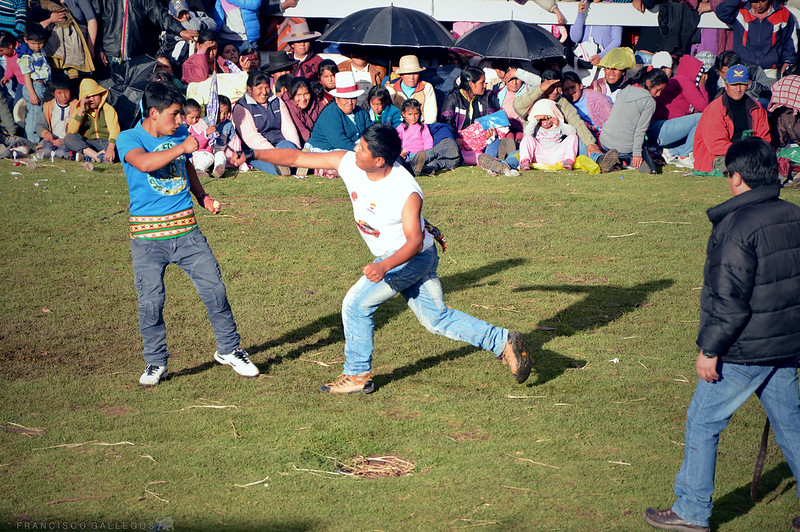Takanakuy
The Andean Festival of Reconciliation by Fist—How Confrontation Creates Year-End Peace and Bonds
2025/12/24
Every December 25th, villages in Peru’s southern Andes—especially in the Chumbivilcas region—erupt with an energy found nowhere else. Takanakuy is a traditional festival where men, women, and even children resolve long-standing grudges and local disputes with their fists. The air is thick with dust and the scent of aguardiente (sugarcane liquor), while the rhythms of huaylia music echo through the streets—a raw, deeply moving Andean celebration that is as honest as it is unforgettable.
Takanakuy is held annually on Christmas Day in towns like Santo Tomás, attracting locals, returning migrants, and curious travelers from around the world. For those who want to experience a living tradition, community justice, and the unique power of ritual to transform conflict into celebration, this is a once-in-a-lifetime destination.
Main Attractions
Fistfights of Resolution
The main attraction of Takanakuy is the public ring, where people of all ages—men, women, and children—settle disputes or test their strength in organized fistfights. Before and after each match, participants embrace, symbolizing reconciliation. The cheers of the crowd, the live music, and the presence of referees create an atmosphere charged with adrenaline and a sense of community unity.
Key Events
The day begins with a colorful parade of participants in traditional costumes, dancing to huaylia music through the village. The main square or bullring becomes the stage for hours of matches. Between fights, everyone enjoys communal meals, music, and toasts with aguardiente. By the end, old grudges are cleared away, and the community is ready to welcome the new year in peace.
Costumes and Decorations
Participants don leather boots, colorful ponchos, embroidered ski masks, and headdresses decorated with feathers or mirrors. Many carry whips or amulets, drawing inspiration from Andean mythology and local folklore. The square is decked out with flags and banners, surrounded by cheering crowds, food stalls, and musicians.
Cultural and Historical Background
“Takanakuy” means “to hit each other” in Quechua, and its origins may reach back to pre-Incan times. Over centuries, Spanish and Catholic influences were added, but the core purpose remained: to resolve year-end grievances and maintain social balance through ritualized combat. Takanakuy embodies Andean values of courage, equality, and community harmony.
While outsiders may see only violence, locals view Takanakuy as a ritual of purification and renewal. Facing each other openly and settling disputes with fists clears the air for the new year. In recent years, anthropologists and travelers have taken a keen interest in this unique tradition and its deeper meaning.
Participant Voices
"As a visitor, I was nervous at first, but the atmosphere was surprisingly festive. I spoke with a woman who settled a score with her cousin; she laughed, ‘Tonight we’ll have Christmas dinner together—no hard feelings.’ That spirit of forgiveness stayed with me."
Fun Facts
- “Takanakuy” is Quechua for “to hit each other.”
- Participants wear ski masks and costumes as symbols of equality and anonymity.
- Some matches are to settle real disputes, others are friendly contests of strength.
Festival Dates
Takanakuy is held every December 25th in Chumbivilcas Province, Cusco, especially in Santo Tomás.
The event schedule is subject to change. Please check the official website for the most up-to-date information.
Information
| Name | Takanakuy |
| Country | Peru |
| Area | Cusco, Chumbivilcas |
| Date | 2025/12/24 |
| Link |
Upcoming Festivals
Dia de la Virgen de Guadalupe Mexico
A Festival Weaving Faith, Fervor, and Mexican Identity
2025/12/11L'Escalade Switzerland
Geneva’s Grand Winter Festival of Courage, Chocolate, and Community
2025/12/12Umkhosi Wokweshwama South Africa
The Zulu First Fruits Festival—A Sacred Celebration of Land, Ancestors, and Renewal
2025/12/12Lucia Festival (St. Lucia's Day) Sweden
A Festival of Light Illuminating the Nordic Darkness
2025/12/15Las Posadas Mexico
The Luminous Quest for Sacred Shelter
2025/12/22Noche de Rabanos (Night of the Radishes) Mexico
A celebration blending art, farming heritage, and cultural traditions
2025/12/23Chant of the Sybil on Majorca Spain
A Medieval Prophecy Echoes Through Majorcan Christmas
2025/12/23‘Hatajo de Negritos’ and the ‘Hatajo de Pallitas’ Peru
A Christmas Festival of Rhythm, Faith, and Afro-Andean Heritage in Peru’s Ica Region
2025/12/24Harbin International Ice and Snow Sculpture Festival China
A Frozen Wonderland Where Art and Adventure Merge
2025/12/24Takanakuy Peru
The Andean Festival of Reconciliation by Fist—How Confrontation Creates Year-End Peace and Bonds

